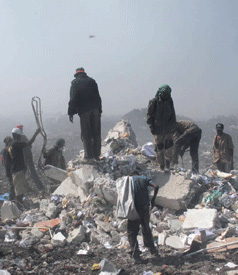The focus on getting clean water for all Haitians is a key part of beating cholera and all waterborne diseases, but another piece of the puzzle – involving the other end of the human consumption system – is just as important.
There is a reason most of Haiti’s water sources – including wells, springs and some aquifers – are contaminated. They are polluted with agricultural run-off, animal waste and human feces.
The first Haitians to fall ill to cholera lived or worked by a river near the United Nations base whose soldiers’ feces are suspected of leaking into the water people used for cooking, drinking and bathing.
“Right now there’s more focus on water, because we can treat water relatively quickly, but in the second and third phase of our National Plan to Fight Cholera, we’re going to focus more on the management of excreta and the construction of latrines,” Pierre-Yves Rochat, responsible for the rural programs of Haiti’s recently created national water and sanitation agency, DINEPA (Direction Nationale de l’Eau Potable et de l’Assainissement), told Haiti Grassroots Watch.
DINEPA is the first national office or agency to have sanitation as part of its mandate. Prior to DINEPA’s creation in 2009, overseeing sanitation fell to cities and towns, but most administrations didn’t take the responsibility seriously. Not one Haitian city or town has a sewer system or sewage treatment center.
No wonder cholera has taken hold so easily.
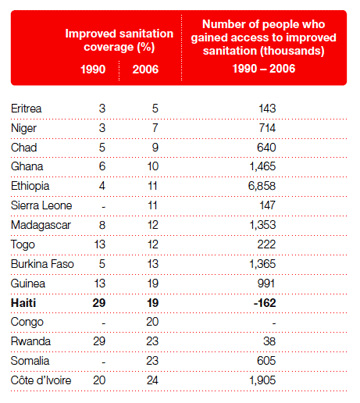
While other countries built sewers under their cities as they expanded, cities like Port-au-Prince just extended its canals up the hillsides. Today, while a small percentage of the population has septic systems, most of the capital’s two million people use latrines or defecate into plastic bags which are then tossed into a mound of garbage or a nearby canal.
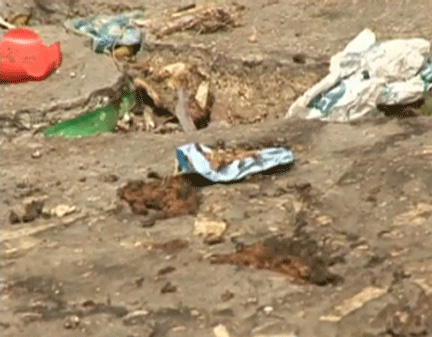
Dangerous Cholera-laced excreta in Cité Soleil?
With the mushrooming of refugee camps and the arrival of thousands of “port-a-potties” – there are now about 15,000 in the capital, according to DINEPA – Haiti had to come face to face with its excreta.
The new desludging industry flourished, and DINEPA and its humanitarian agency partners scrambled for a place to dump it all. They dug a pit at the Trutier city dump north of the capital.
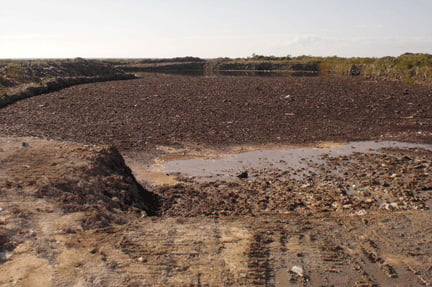
Temporary, because a new dump waste-treatment site being prepared further north, in Titayen, is slated to come on line the first week of January. [see From Emergency to Self-Sufficiency?] But “temporary” has now been going on for many months.
And in the meantime, untreated human waste – likely containing cholera bacteria and many other water- and excrement-borne diseases – has been dumped into the open pit which sits about 2 kilometers from Duvivier, and very near the normal Trutier dump site where about 250 families actually live and sort medical waste and other garbage.
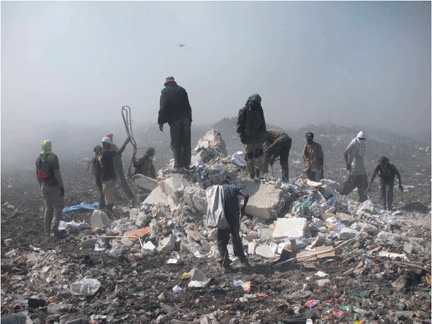
On December 1, the alarm was sounded at the weekly meeting of the Water and Sanitation (WASH) Cluster – chaired by DINEPA and UNICEF and which brings together the government and non-governmental agencies who have been working together since the earthquake.
Asia Ghemri, from the UN Office for Project Services (UNOPS) Operations office which is working with DINEPA to organize excreta management, told colleagues: “The excreta pool is almost full.”
“It’s only a matter of weeks,” she added.
The community just downwind – Duvivier – is fed up.
“We are mobilizing against it. We can’t take the bad odor, and now with cholera, its dangerous,” Salvatory St. Victor of the Committee for the Relaunching of Duviver (KRD) told Haiti Grassroots Watch on Dec. 15. “Also what if those germs go down to the aquifer?”
(Three days later, St. Victor and hundreds of other Duvivier residents demonstrated at the entrance to the stinking pool. One Duvivier resident was shot and killed by police, according to AlterPresse and Haiti Libre. In December 21 note, KRD said three people were killed during and just after the demonstration.)
The unlined pit – which is the size of about four soccer fields – sits on top of the Plaine Cul-de-Sac aquifer, one of the principal water sources for the metropolitan region. Many worry that cholera-contaminated Trutier excreta might leach down into the Cul-de-Sac Plain aquifer, from which many private water truck companies pump thousands of gallons a day.
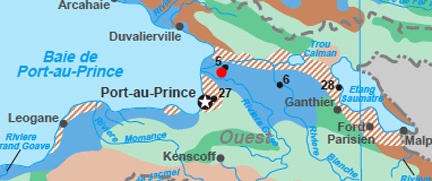
U.S. Army Water Resources Assessment of Haiti report.
Already in 2002, a study noted that the aquifer water was feces-infected.
On Dec. 15, Dr. Homero Silva of the Pan-American Health Organization (PAHO) confirmed what many feared.
“There is a danger that the bacteria can go down to the aquifer or out to the sea,” Silva told colleagues at the Dec. 15 WASH Cluster meeting. “Vibrio cholera can live for many years.”
Silva used to work in Peru, where a cholera outbreak there spread across Latin America and sickened hundreds of thousands. It is now believed the bacteria lived in the ocean and arrived in several port cities at once.
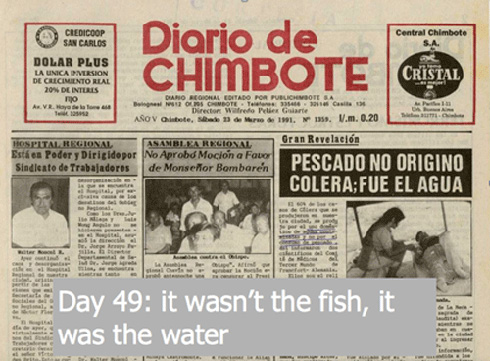
“There are definitely serious concerns about what is happening there,” she told the meeting.
DINEPA’s Rochat agreed, and told Haiti Grassroots Watch that testing is taking place, although results are not yet back.
“When all the excreta trucks stop dumping their materials in Trutier, we need to define a plan to decontaminate the site, if there is a need to do that,” he said.
As of Dec. 17, excreta trucks were still dumping at Trutier.
Camps Offer Special Challenge
The capital region’s refugee camps offer a particular challenge.
Currently there about 1 to 1.3 million people living in refugee camps in the capital and three other cities worse-hit by the January 12 earthquake. Some camps have in-ground latrines, which are already overflowing, and others have latrines that need to be pumped out every day.
According to “Sphere standards” for humanitarian disasters, there is supposed to be one latrine for every twenty people, but a June report from the UN Office of Humanitarian Affairs puts the number closer to about one latrine for every 50 to 100 camp-dwellers.
Bon Berger camp in Mariani, south of the capital, has none. About 250 to 300 families live in tents and shanties crammed into an area not much larger than a soccer field. Soon after the January 12 earthquake, CARE built some latrines they called “emergency,” according to Renol Jeudi Jean, the camp manager. But after six months, “they got filled up” and they have yet to be replaced.
“Since then, people have been doing what they need to do on the edges of the camp,” Jean told Haiti Grassroots Watch.
To confirm Jean’s claim, Haiti Grassroots Watch randomly surveyed six refugee families. All of them reported using plastic bags, or simply squatting in the weeds on the nearby riverbank.
Not all camps lack latrines, but many lack the correct quantity, or they are not emptied as often as they should be. Latrines routinely “fill up” and can spill or, as occurred earlier this month, can be overturned by protestors.
Also Read:
Behind the Cholera Epidemic: Introduction
We’re not backing down in the face of Trump’s threats.
As Donald Trump is inaugurated a second time, independent media organizations are faced with urgent mandates: Tell the truth more loudly than ever before. Do that work even as our standard modes of distribution (such as social media platforms) are being manipulated and curtailed by forces of fascist repression and ruthless capitalism. Do that work even as journalism and journalists face targeted attacks, including from the government itself. And do that work in community, never forgetting that we’re not shouting into a faceless void – we’re reaching out to real people amid a life-threatening political climate.
Our task is formidable, and it requires us to ground ourselves in our principles, remind ourselves of our utility, dig in and commit.
As a dizzying number of corporate news organizations – either through need or greed – rush to implement new ways to further monetize their content, and others acquiesce to Trump’s wishes, now is a time for movement media-makers to double down on community-first models.
At Truthout, we are reaffirming our commitments on this front: We won’t run ads or have a paywall because we believe that everyone should have access to information, and that access should exist without barriers and free of distractions from craven corporate interests. We recognize the implications for democracy when information-seekers click a link only to find the article trapped behind a paywall or buried on a page with dozens of invasive ads. The laws of capitalism dictate an unending increase in monetization, and much of the media simply follows those laws. Truthout and many of our peers are dedicating ourselves to following other paths – a commitment which feels vital in a moment when corporations are evermore overtly embedded in government.
Over 80 percent of Truthout‘s funding comes from small individual donations from our community of readers, and the remaining 20 percent comes from a handful of social justice-oriented foundations. Over a third of our total budget is supported by recurring monthly donors, many of whom give because they want to help us keep Truthout barrier-free for everyone.
You can help by giving today. Whether you can make a small monthly donation or a larger gift, Truthout only works with your support.
